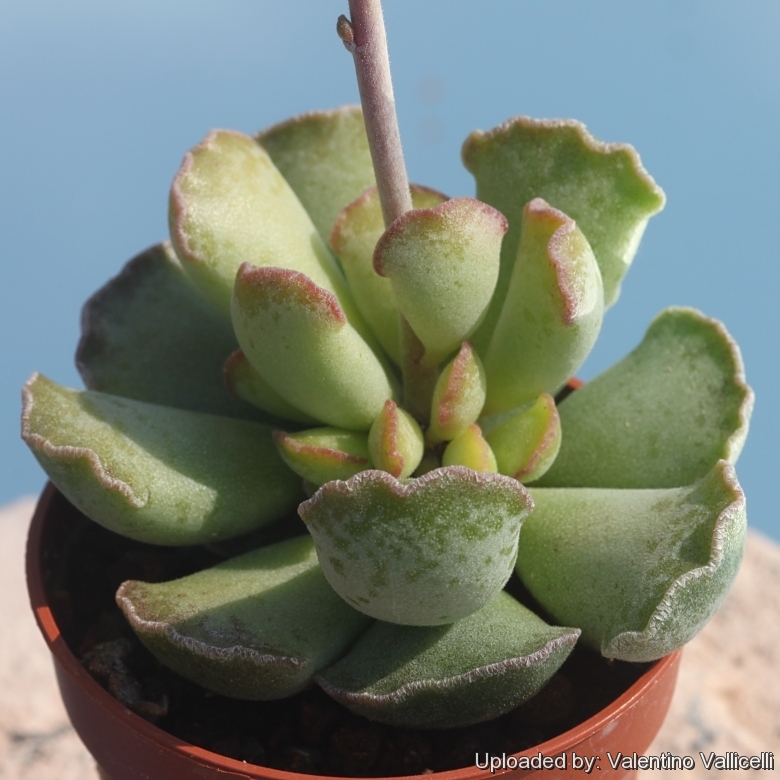
Adromischus cristatus Photo by: Valentino Vallicelli
Origin and Habitat: Lower Baviaanskloof and Langkloof west of Humansdorp, Eastern Cape, South Africa.
Habitat: This adromischus is a typical component of the Eastern Cape succulent thickets found in sheltered and shaded rock outcrops and rocky slopes, but never common.
Synonyms:
See all synonyms of Adromischus cristatus
Common Names include:
CHINESE (中文): 天章
Description: Adromischus cristatusSN|134]]SN|134]] (cristate adromischus) is an exquisite dwarf succulent plant with a few rosettes formed by fat reverse trianglular leaves, with felt-like texture and characteristic crested, wavy distal leaf margins. It is a peculiar species that is unlikely to be confused with other. It also easily recognized by the short stem wrapped in a thick coat of reddish, tangled, wiry, hairlike aerial roots. It is very variable.
Roots: Fibrous.
Stems: Erect 2-5(-8) cm tall with fibrous roots at base. and glandular hairs on stem.
Leaves: 1,5-5 cm long, 5-20 mm broad, inflated, reversed-triangular to oblong-elliptic, terete to somewhat dorsiventrally compressed, green to grey-green, tip truncate or rounded to more or less broadened and crisped, base wedge-shaped to petiolate. Margin in upper half of the leaf horny, undulate, often darker. Sometimes covered with glandular hairs, usually glabrescent or glabrous, green to grey-green often with darker markings.
Inflorescence: Spike-like thyrse with 1-flowered cyme 10-20 cm high, grey-green.
Flowers: Buds terete. slightly grooved, gradually tapered towards tip, erect at first, later spreading. Flowers 1-1,2 cm, calyx 1,5-3 mm long, grey-green, corolla-lobes 2-1,5 mm wide, ovate-triangular, acute,white tinged pink, with darker margin, spreading or recurved, rough and with club-shaped hairs mainly in throat. Anthers 0,6-0,9 mm long, not protruding from corolla-tube. Squamae about square, 1-1,2 mm long and broad. Pedicels 1-2 mm long.
Adromischus cristatusSN|134]]SN|134]] var. cristatus: is much-branched about 4 cm tall, has red aerial roots and red hairs on the stem, and reversed-triangular leaves, which have much-broadened margins at the tip.
Subspecies, varieties, forms and cultivars of plants belonging to the Adromischus cristatus group
 Adromischus cristatus Lem.: (var. cristatus) has ridge at tip of leaf constitutes broadest point of leaf. Leaf-blade 1-1,5 times longer than breadth of apical ridge, leaves reversed-triangular. Distribution: Eastern cape.
Adromischus cristatus Lem.: (var. cristatus) has ridge at tip of leaf constitutes broadest point of leaf. Leaf-blade 1-1,5 times longer than breadth of apical ridge, leaves reversed-triangular. Distribution: Eastern cape. Adromischus cristatus var. clavifolius (Haw.) Toelken: has leaves 2-5 times longer than breadth of apical ridge, reversed-triangular to club-shaped, hairless nearly so. Distribution: Alexandria, Grahamstown and East London (Cape Province).
Adromischus cristatus var. clavifolius (Haw.) Toelken: has leaves 2-5 times longer than breadth of apical ridge, reversed-triangular to club-shaped, hairless nearly so. Distribution: Alexandria, Grahamstown and East London (Cape Province).- Adromischus cristatus var. mzimvubuensis van Jaarsv.: has felted leaves covered with fine glandular hairs. Distribution: Mzimvubu River, Eastern Cape.
 Adromischus cristatus var. schonlandii (E.Phillips) Toelken: has stems 2-4 cm long, covered with aerial roots. Ridge at tip of leaves narrower than broadest point on leaf, inflorescence with glandular hairs.
Adromischus cristatus var. schonlandii (E.Phillips) Toelken: has stems 2-4 cm long, covered with aerial roots. Ridge at tip of leaves narrower than broadest point on leaf, inflorescence with glandular hairs. Adromischus cristatus var. zeyheri (Harv.) Toelken: has stems 4-8 cm long, without aerial roots, covered with glandular hairs. Distribution: Baviaanskloof , Eastern Cape.
Adromischus cristatus var. zeyheri (Harv.) Toelken: has stems 4-8 cm long, without aerial roots, covered with glandular hairs. Distribution: Baviaanskloof , Eastern Cape.
Bibliography: Major references and further lectures
1) James Cullen, Sabina G. Knees, H. Suzanne Cubey “The European Garden Flora Flowering Plants: A Manual for the Identification of Plants Cultivated in Europe, Both Out-of-Doors and Under Glass” Cambridge University Press, 11/ago/2011
2) J.P. Roux “Flora of South Africa“ 2003
3) Ben P. Barkhuizen “Succulents of Southern Africa: With Specific Reference to the Succulent Families Found in the Republic of South Africa and South West Africa” Purnell, 1978
4) Domitilla Raimondo “Red list of South African plants 2009” South African National Biodiversity Institute, 2009
5) Ernst Van Jaarsveld, Ben-Erik Van Wyk, Gideon Smith “Succulents of South Africa: A Guide to the Regional Diversity” Tafelberg Publishers, Limited, 01/lug/2000
6) Wilhelm von Roeder “Sukkulenten; ein Führer für Liebhaber und Sammler durch das Reich der Fettpflanzen” Stuttgart, Franckh 1931
7) Hermann Jacobsen “A Handbook of Succulent Plants: Abromeitiella to Euphorbia” Blandford Press, 1960
8) Werner Rauh “Die großartige Welt der Sukkulenten : Anzucht und Kultur sukkulenter Pflanzen mit Ausnahme der Kakteen” Hamburg; Berlin: P. Parey, cop. 1967.
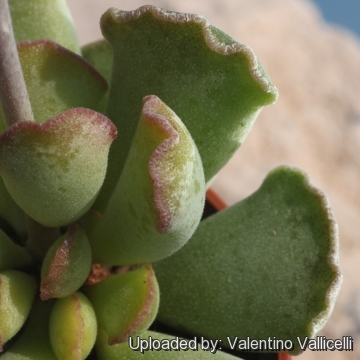 Adromischus cristatus Photo by: Valentino Vallicelli
Adromischus cristatus Photo by: Valentino Vallicelli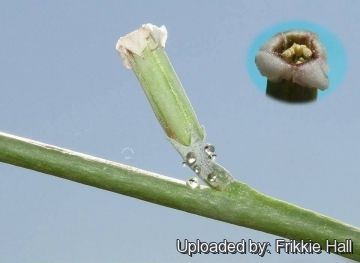 Adromischus cristatus Photo by: Frikkie Hall
Adromischus cristatus Photo by: Frikkie Hall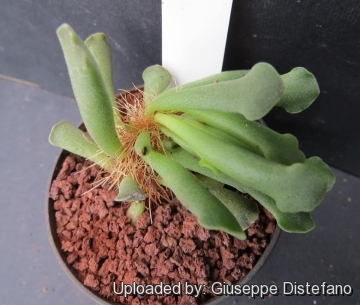 It is easily recognized by the short stem wrapped in a thick coat of reddish, tangled, wiry, hairlike aerial roots. Photo by: Giuseppe Distefano
It is easily recognized by the short stem wrapped in a thick coat of reddish, tangled, wiry, hairlike aerial roots. Photo by: Giuseppe Distefano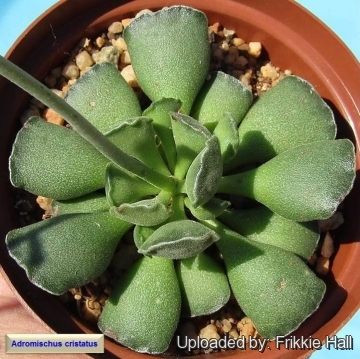 Adromischus cristatus Photo by: Frikkie Hall
Adromischus cristatus Photo by: Frikkie HallCultivation and Propagation: Adromischus cristatusSN|134]]SN|134]] is a fairly easy succulent to grow and one of the easier Adromischus speciest.
Growth rate: Adromischus cristatusSN|134]]SN|134]] is a popular, fast growing species.
Soil: It prefer well-drained soil.
Repotting: Repot every other years. All species of this genus are happy in small pots.
Exposure: It grows best in a partially shaded position. It got sunburned if exposed to midday sun.
Hardiness: Require a minimum temperature 5°C (But hardy down to -7°C for short periods), with good drainage and dryness in winter to resist the cold.
Watering: It takes more water than cacti, but let the soil dry between soaking, in the wild, it receives rain mostly in spring and fall. Must have very dry atmosphere. Water less in winter but do not allow it to shrivel.
Pest & disease: It is vulnerable to mealybugs and rarely scale. It is prone to rotting from the tuberous base or from dried inflorescences.
Maintenance: As the plant matures, the centre becomes bare. When it does, restart it from side cuttings and throw away the central part.
Propagation: Usually propagate from single leaves (leaf cuttings) or stem cuttings seed propagation is rarely used. Leaves easily root and produce new plants. Twist off a leaf and permit it to dry out a couple of days, lay it on the soil and insert the stem end partially into the soil. The original leaf should not be removed until it has dried up. Try to keep the leaf somewhat upright so that the roots are able to grow downward. If grown in a container, bottom watering by immersing the container is recommended.














